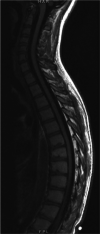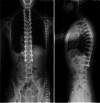Scheuermann Kyphosis: Current Concepts and Management
- PMID: 37615931
- PMCID: PMC10587050
- DOI: 10.1007/s12178-023-09861-z
Scheuermann Kyphosis: Current Concepts and Management
Abstract
Purpose of review: Scheuermann's kyphosis (SK) is a developmental deformity of the spine that affects up to 8% of children in the US. Although, the natural progression of SK is noted to be gradual over years, severe deformity can be associated with significant morbidity. Thorough clinical examination and interpretation of relevant imaging help differentiate and confirm this diagnosis. Treatment includes both operative and nonoperative approaches. The purpose of this article is to provide an updated overview of the current theories of its pathogenesis, as well as the principles of diagnosis and treatment of SK.
Recent findings: Although a definitive, unified theory continues to be elusive, numerous reports in the past decade provide insight into the pathophysiology of SK. These include alterations in mechanical stress and/or hormonal disturbances. Candidate genes have also been identified to be linked to the inheritance of SK. Updates to nonoperative treatment include the effectiveness of dedicated exercise programs, as well as the types and duration of orthotic treatment. Advances in surgical technique can be observed with a trend toward a posterior-only approach, with supporting evidence for careful evaluation of both the sagittal and coronal planes to determine fusion levels in order to avoid postoperative junctional pathologies. SK is an important cause of structural or rigid kyphosis. It can lead to significant morbidity in severe cases. Treatment is based on curve magnitude and symptoms. Nonoperative treatment consists of physical therapy in symptomatic patients, and bracing can be added for skeletally mature patients. Operative management can be considered in patients with large, progressive, and symptomatic deformity. Future studies can benefit from a focused investigation into patient-reported outcomes after undergoing appropriate treatment.
Keywords: Adolescent kyphosis; Hyperkyphosis; Scheuermann’s kyphosis; Spine deformity.
© 2023. The Author(s), under exclusive licence to Springer Science+Business Media, LLC, part of Springer Nature.
Conflict of interest statement
The authors declare no competing interests.
Figures




References
-
- Yaman O, Dalbayrak S. Kyphosis and review of the literature. Turk Neurosurg. Published online 2013. 10.5137/1019-5149.JTN.8940-13.0. - PubMed
Publication types
LinkOut - more resources
Full Text Sources
Research Materials
Miscellaneous

